The Ultimate Guide to Halloween Activities & Games for Kids
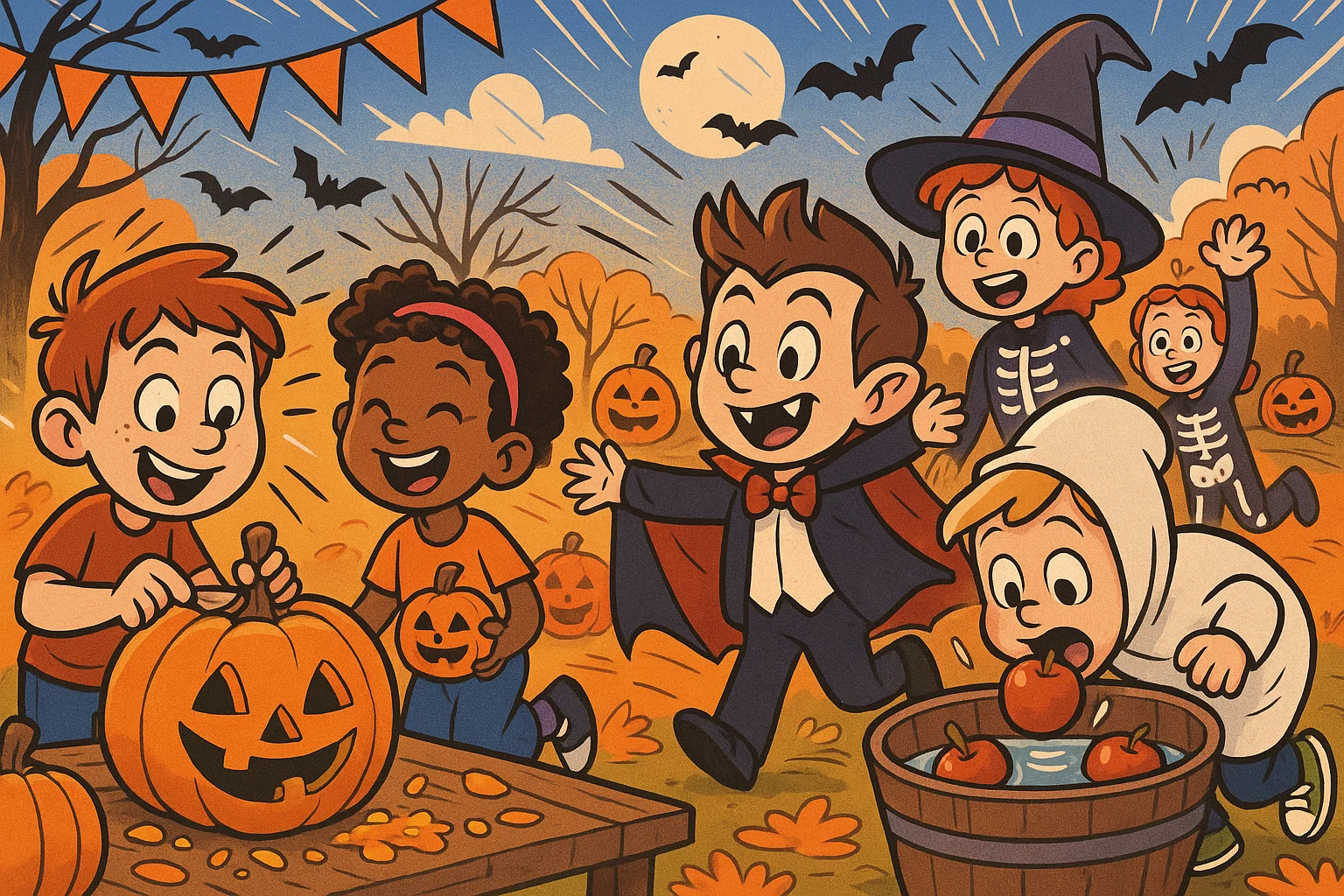
Halloween presents the perfect opportunity to engage children in memorable experiences that combine fun with learning. Whether you’re a parent, teacher, or caregiver, this comprehensive guide offers dozens of creative Halloween activities that will keep kids entertained while fostering their development. From simple crafts to educational games, these Halloween activities cater to various ages and skill levels, ensuring every child can participate in the autumn festivities.
Quick & Easy Halloween Activities ⚡
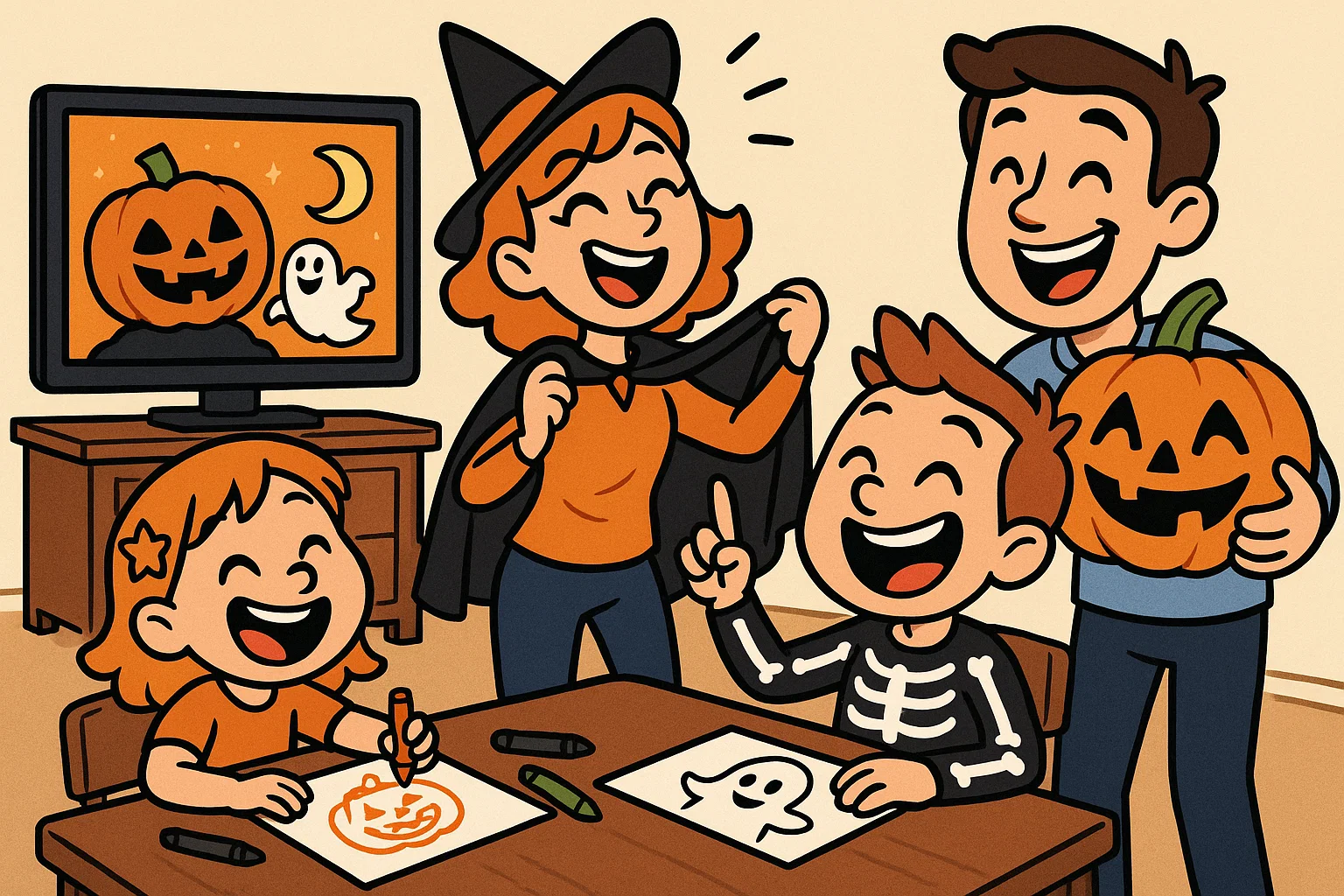
When time is limited but you want to create Halloween magic, these simple activities deliver maximum impact with minimal preparation. Each Halloween activity requires basic materials you likely have at home and can be completed in 30 minutes or less.
Watch a Halloween Video
Curate age-appropriate Halloween content that balances entertainment with educational value. Research from the American Academy of Pediatrics suggests that children benefit from guided media consumption, making this an ideal opportunity for family bonding.
Best practices for Halloween video time:
- Choose videos under 20 minutes for younger children
- Preview content to ensure it matches your child’s comfort level with spooky themes
- Encourage discussion about characters and storylines
- Consider educational Halloween documentaries about pumpkin growing or costume history
Tell Halloween Jokes
Humor plays a crucial role in child development, and Halloween jokes offer a perfect blend of seasonal fun and cognitive benefits. According to child development experts, joke-telling helps kids understand wordplay, timing, and social interaction.
Sample kid-friendly Halloween jokes:
- “What do you call a witch’s garage? A broom closet!”
- “Why don’t ghosts like rain? It dampens their spirits!”
- “What’s a vampire’s favorite fruit? A blood orange!”
Do a Halloween Word Search
Word searches enhance vocabulary recognition and visual scanning skills. Create custom Halloween puzzles featuring spooky vocabulary appropriate for your child’s reading level, or find printable versions online that incorporate Halloween terms.
Pose Halloween Trivia Questions
Trivia games stimulate memory recall and encourage learning about Halloween traditions. Tailor questions to your child’s age group, covering topics from pumpkin facts to costume history.
Age-appropriate Halloween trivia categories:
- Halloween traditions around the world
- Pumpkin growing and harvesting
- Costume origins and meanings
- Halloween safety facts for trick-or-treating
Solve a Halloween Word Scramble
Word scrambles challenge problem-solving skills while reinforcing spelling patterns. Start with simple three-letter Halloween words for younger children and progress to more complex vocabulary for older kids.
Color Halloween Coloring Pages
Coloring remains one of the most beneficial quiet activities for children, promoting fine motor development and creativity. Research from the Journal of Arts & Humanities indicates that coloring can reduce anxiety and improve focus in children.
Make a DIY Halloween Costume
Encourage creativity by helping kids design their own Halloween costumes using household items. This activity develops problem-solving skills and artistic expression while being budget-friendly.
Simple Halloween costume ideas using common materials:
- Ghost: white sheet with eye holes
- Robot: cardboard boxes and aluminum foil
- Cat: black clothing with paper ears and tail
Have a Halloween Movie Night
Transform your living room into a cozy Halloween theater. Select movies that match your family’s comfort level with spooky content, and enhance the experience with themed snacks and decorations.
Make Your Own Slime
Slime-making combines science education with sensory play. This hands-on activity teaches basic chemistry concepts while providing tactile stimulation that many children find calming and engaging.
Basic Halloween slime recipe:
- 1 cup white glue
- 1 tablespoon saline solution
- Orange or black food coloring
- Halloween add-ins (plastic spiders, googly eyes)
Spooky Arts-and-Crafts Activities 🎨
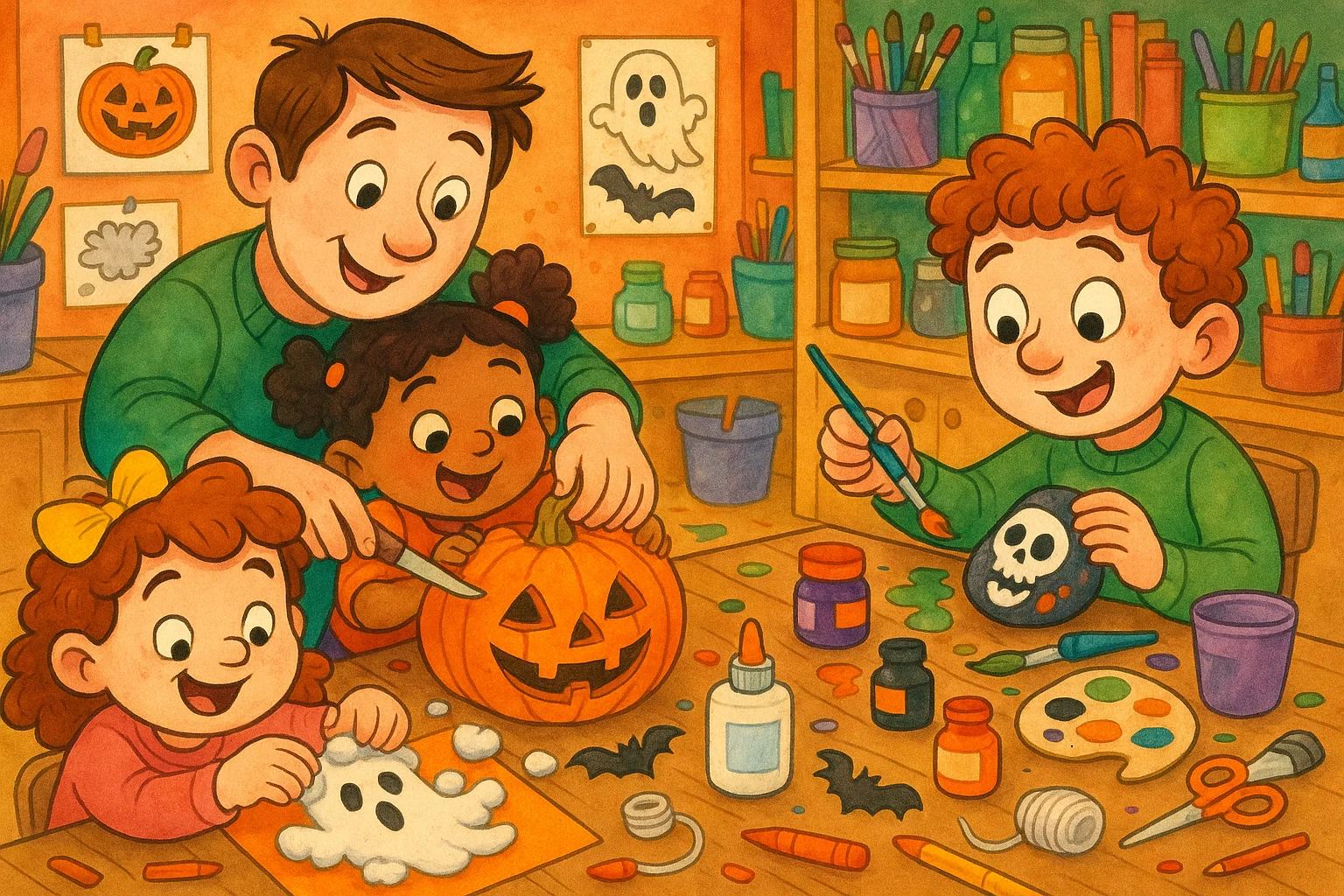
Spooky-Arts-and-Crafts-Cartoon.webp
Arts and crafts activities during autumn provide children with opportunities to express creativity while developing fine motor skills and artistic techniques. These projects range from simple drawing exercises to more complex multi-step crafts.
Draw a Pumpkin
Teaching children to draw pumpkins helps develop observational skills and artistic technique. Start with basic shapes and gradually add details like stems, vines, and facial features for jack-o’-lanterns.
Step-by-step pumpkin drawing guide:
- Begin with a large circle
- Add vertical curved lines for pumpkin sections
- Draw a small rectangle on top for the stem
- Add curved lines for dimension
- Color with orange and green
Monster Roll-and-Draw
This creative game combines chance with artistic expression. Children roll dice to determine which monster features to draw, resulting in unique and often hilarious creatures.
Beaded Pipe Cleaner Pumpkins
This craft develops fine motor skills while creating decorative autumn pieces. Children thread orange beads onto pipe cleaners, then shape them into pumpkin forms.
Jack-o’-lantern Lacing Plates
Lacing activities strengthen hand-eye coordination and prepare children for future writing tasks. Paper plates with pre-punched holes and orange yarn create perfect seasonal lacing practice.
Spooky Painted Rocks
Rock painting encourages artistic expression while creating lasting decorations. Children can transform ordinary stones into ghosts, pumpkins, or monsters using acrylic paints.
Pumpkin Carving
Traditional pumpkin carving remains a beloved autumn activity, though it requires adult supervision and age-appropriate tools. For younger children, consider foam pumpkins as safer alternatives.
Safety considerations for pumpkin carving:
- Always supervise children with sharp tools
- Use plastic carving tools for younger kids
- Let children design while adults handle cutting
- Provide LED candles instead of real flames
Drinking-Straw Skeletons
This engineering-focused craft teaches children about human anatomy while developing construction skills. White drinking straws and pipe cleaners create moveable skeleton models.
Cotton Ball Ghosts
Simple yet effective, cotton ball ghosts require minimal materials while producing charming decorations. Children stretch cotton balls and add small faces with markers.
Yarn Tassel Ghosts
Yarn tassels create textured, three-dimensional ghost decorations. This craft introduces children to basic fiber arts techniques while producing autumn decor.
Make Spooky Crafts and Decorations
Encourage children to design their own seasonal decorations using various materials. This open-ended activity promotes creativity and problem-solving skills.
Turn Your Backyard into a Haunted House
Transform outdoor spaces into spooky wonderlands using child-safe materials. This large-scale project encourages planning, teamwork, and creative problem-solving.
Halloween Games for Kids 🎮
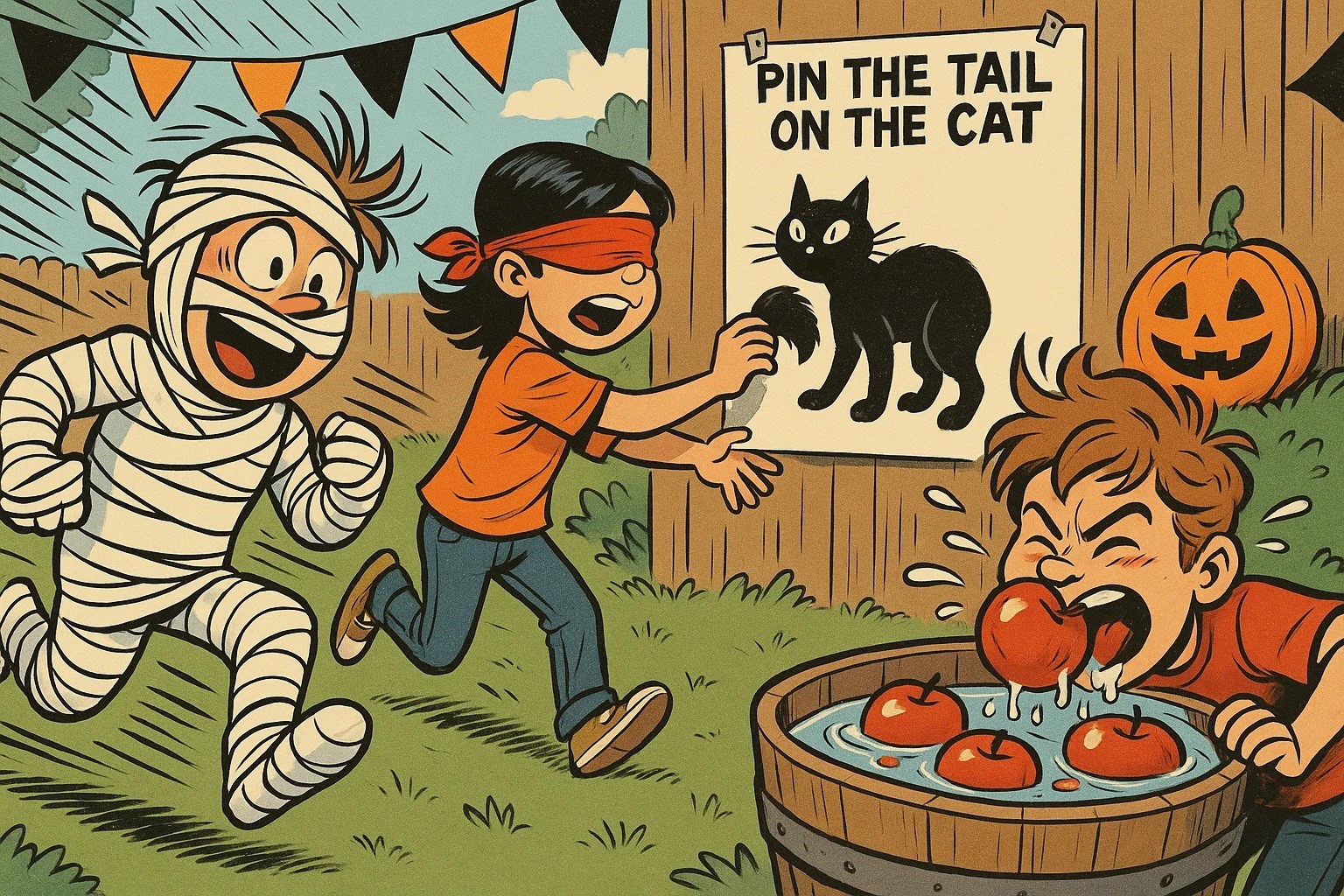
Interactive games provide physical activity, social interaction, and skill development opportunities. These Halloween-themed games accommodate various group sizes and age ranges.
Bobbing for Apples
This traditional Halloween game promotes coordination and provides sensory experiences. For hygiene concerns, consider individual bowls or apple-fishing with spoons as alternatives.
Mini Masquerade
Costume parades allow children to showcase creativity while building confidence. Create a runway in your living room or classroom for kids to model their Halloween costumes.
Kiddo-sized Maze
Design age-appropriate mazes using cardboard boxes or hay bales. Mazes develop spatial reasoning and problem-solving skills while providing physical activity.
Mummy Race
This active Halloween game involves wrapping team members in toilet paper or gauze. It promotes teamwork and coordination while incorporating seasonal themes.
Mystery Box
Sensory guessing games stimulate tactile exploration and descriptive language skills. Fill boxes with Halloween-themed items for children to identify by touch alone.
Pin the Tail on the Black Cat
This Halloween variation of a classic party game develops spatial awareness and following directions. Create large cat silhouettes and provide construction paper tails.
Zombie Musical Chairs
Add Halloween flair to traditional musical chairs by incorporating zombie movements. This game combines music, movement, and following directions.
Pumpkin Sweep
Using small pumpkins and brooms, children navigate obstacle courses while developing gross motor skills and coordination.
Pumpkin Beanbag Toss
Create targets using cardboard pumpkins with different sized openings. This Halloween game develops hand-eye coordination and provides opportunities for friendly competition.
Halloween Bingo
Educational Halloween bingo games reinforce vocabulary recognition while providing group entertainment. Create cards featuring spooky images or words appropriate for your child’s reading level.
Ghost and Pumpkin Bowling
Set up bowling pins decorated as ghosts and pumpkins. This Halloween game develops coordination while incorporating seasonal themes.
Witch Hat Ring Toss
Cone-shaped witch hats serve as targets for ring toss games. This activity develops hand-eye coordination and provides opportunities for turn-taking practice.
Halloween Charades or Pictionary
These classic games adapt perfectly to Halloween themes while developing communication skills and creative expression.
Frightful Flashlight Scavenger Hunt
Evening scavenger hunts using flashlights add excitement while developing observation skills and following directions.
Trick-or-Treat Relay Race
Team-based races incorporating Halloween elements promote physical activity and cooperation while maintaining seasonal themes.
Educational Halloween Activities 📚
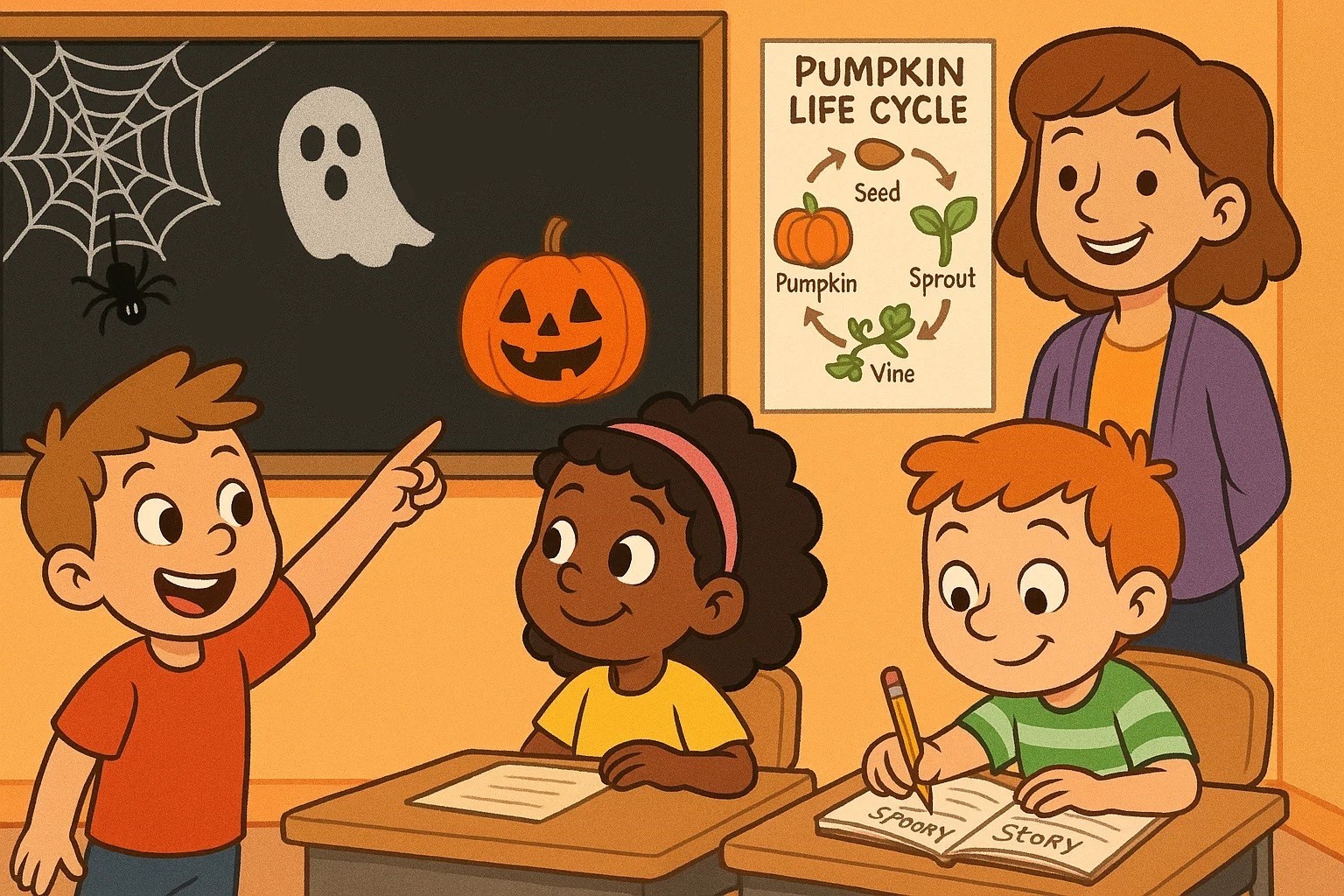
October provides excellent opportunities to integrate learning with seasonal fun. These activities demonstrate how academic concepts can be taught through engaging, thematic approaches.
ELA Seasonal Activities
Language arts skills develop naturally through autumn-themed reading, writing, and speaking activities. Research from the Journal of Practical Studies in Education shows that contextual learning improves retention and engagement in young learners.
Effective ELA seasonal activities include:
- Creative writing prompts about spooky adventures
- Autumn vocabulary building exercises
- Storytelling activities featuring seasonal characters
- Poetry writing using October themes
- Reading comprehension with seasonal stories
Science and Math Autumn Activities
STEM subjects integrate seamlessly with October themes, making abstract concepts more concrete and engaging for children.
Science activities:
- Pumpkin lifecycle exploration
- Weather observations during October
- Simple chemistry experiments using autumn colors
- Seed counting and measurement activities
Math activities:
- Candy counting and sorting
- Pumpkin measuring and weighing
- Seasonal word problems
- Geometric shape recognition in decorations
Spooky Books, Poems, and Read-Alouds
Literature exposure during October introduces children to various genres while maintaining seasonal interest. Select books that match your child’s reading level and comfort with spooky themes.
Recommended reading strategies:
- Interactive read-alouds with discussion questions
- Student-led book reports on autumn stories
- Poetry recitation featuring seasonal verses
- Author studies of spooky book writers
Halloween Sensory Bins
Sensory exploration supports learning across multiple developmental domains. Autumn sensory bins provide tactile experiences while incorporating seasonal themes.
Effective sensory bin materials:
- Orange and black rice or beans
- Small seasonal figurines
- Textured materials like fake spider webs
- Scoops, tongs, and sorting containers
Explore the Pumpkin Life Cycle
This comprehensive science unit teaches children about plant biology while maintaining October connections. Students observe, record, and discuss each stage of pumpkin development.
| Life Cycle Stage | Key Characteristics | Educational Focus |
| Seed | Small, flat, white | Plant parts, germination |
| Sprout | First green shoots | Growth requirements |
| Vine | Long, spreading growth | Plant structure |
| Flower | Yellow blossoms | Pollination process |
| Fruit | Growing pumpkin | Harvest timing |
FAQ
What age groups are these Halloween activities suitable for?
Most activities can be adapted for children ages 3-12. Younger children may require more adult assistance, while older kids can handle more complex projects independently. Always consider individual developmental levels when selecting activities.
How can I make seasonal activities educational without losing the fun factor?
Integration is key. Choose activities that naturally incorporate learning objectives, such as counting candy for math skills or reading autumn stories for literacy development. Children learn best when they don’t realize they’re learning.
Are these activities suitable for classroom use?
Yes, most activities adapt well to classroom settings. Consider space limitations, supervision requirements, and time constraints when planning. Many activities can be completed in standard class periods.
How can I accommodate children who might be scared of spooky themes?
Focus on friendly, non-threatening elements like pumpkins, autumn leaves, and harvest themes. Avoid scary monsters or frightening decorations, and always respect individual comfort levels.
What supplies do I need to have on hand for these activities?
Basic craft supplies include construction paper, crayons, glue sticks, scissors, and markers. Many activities use common household items like toilet paper, cotton balls, and cardboard boxes. Specific supply lists can be created based on chosen activities.
